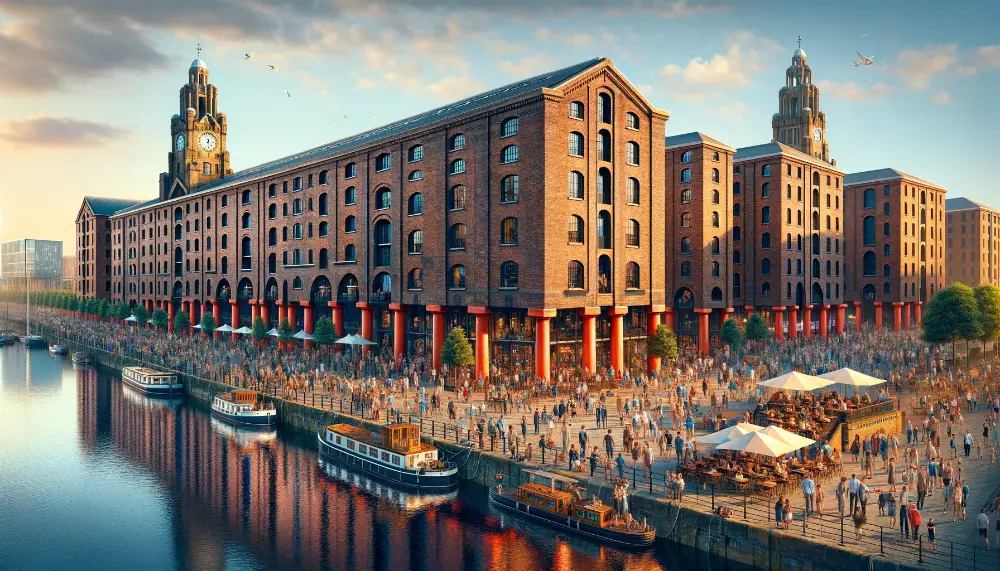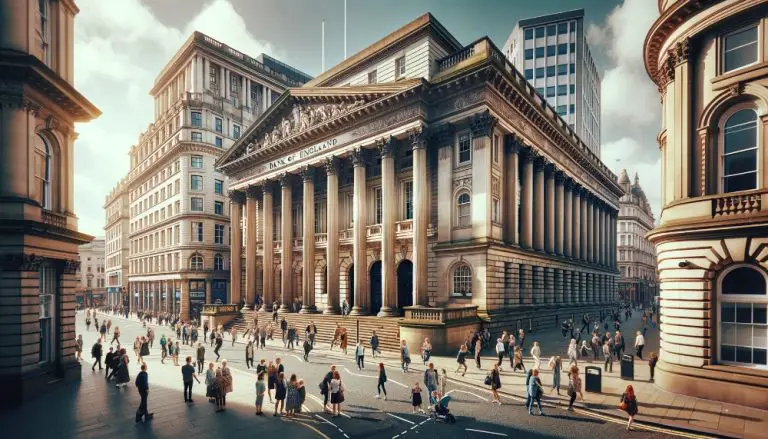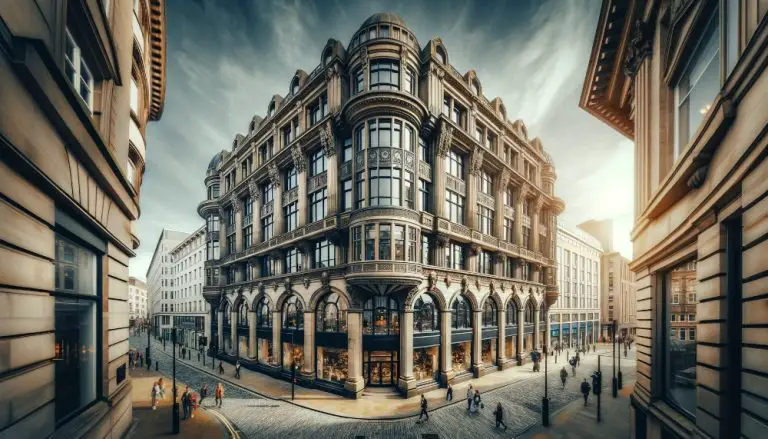Albert Dock Warehouses: A Stunning Transformation of Liverpool’s Waterfront

The Albert Dock Warehouses, located on the picturesque waterfront of Liverpool, have undergone a remarkable conversion from historic dock buildings to a vibrant destination for shopping, dining, and accommodation. The warehouses, named A, B, C, D, and E, were designed by Jesse Hartley and Philip Hardwick and were opened in 1846, making them the first non-combustible structures in Britain. Today, these warehouses stand as a testament to architectural ingenuity and have become a must-visit attraction for tourists and locals alike.
The transformation of the Albert Dock Warehouses has breathed new life into these historic buildings, offering visitors a glimpse into Liverpool’s maritime heritage. The warehouses have been lovingly converted into unique shopping experiences, dining establishments, and even dockside accommodation, allowing visitors to immerse themselves in the rich history and charm of the Liverpool waterfront.
Key Takeaways:
- Albert Dock Warehouses: Once used for trade, now a vibrant tourist attraction.
- Historic significance: The warehouses played a crucial role in Liverpool’s maritime history.
- Architectural marvel: These warehouses are considered an architectural feat.
- Royal Albert Dock: The warehouses received a royal charter and are part of a UNESCO World Heritage Site.
- Economic impact: The redevelopment has brought new life and economic growth to Liverpool.
History of Albert Dock Warehouses
The history of the Albert Dock Warehouses dates back to 1837 when plans were first developed by Jesse Hartley and Philip Hardwick for a combined dock and warehouse system. The warehouses were designed to allow ships to be loaded and unloaded directly from the quaysides, using innovative hydraulic cranes.
In the late 19th and early 20th centuries, the warehouses played a crucial role in global trade, storing valuable cargoes such as cotton, tea, silk, and tobacco. Their strategic location on the Liverpool waterfront made them a hub for maritime activity and contributed to Liverpool’s status as a major port city.
However, with the advancements in steamships and the need for larger docks, the Albert Dock Warehouses faced challenges in accommodating the changing needs of the shipping industry. As a result, they eventually closed in 1972.
Transformation and Regeneration
After lying derelict for nearly ten years, the Albert Dock Warehouses underwent a major regeneration project in the 1980s. The Merseyside Development Corporation oversaw the redevelopment, and the warehouses were officially reopened in 1984.
Today, the Albert Dock Warehouses have been transformed into a bustling tourist attraction in Liverpool. With their rich history and prime waterfront location, they offer a multitude of cultural, dining, and entertainment experiences for visitors to enjoy.
These historic warehouses have been converted into various attractions that showcase the unique heritage of Liverpool. Here, visitors can explore museums, delve into the story of the famous Beatles at the Beatles Story, discover the maritime history of the region at the Merseyside Maritime Museum, or enjoy modern and contemporary art at the Tate Liverpool.
The transformation of the Albert Dock Warehouses has also extended beyond the buildings themselves. The area surrounding the warehouses now boasts a range of hotels and restaurants, making it an ideal destination for tourists seeking not only culture but also a comfortable and enjoyable stay.
| Attractions | Description |
|---|---|
| Merseyside Maritime Museum | A museum dedicated to the maritime history of Liverpool and the wider region. It showcases artifacts, exhibitions, and interactive displays. |
| The Beatles Story | An immersive experience that tells the story of the world-famous band, from their humble beginnings to global superstardom. |
| Tate Liverpool | A branch of the renowned Tate art galleries, featuring modern and contemporary art exhibitions. |
| Hotels | A selection of hotels offering comfortable accommodation with stunning views of the dock and Liverpool’s iconic waterfront. |
| Restaurants | A diverse range of dining options, from casual cafes to fine dining establishments, serving both local and international cuisine. |
Architectural Features
The Albert Dock Warehouses stand as an architectural feat, showcasing a unique design and construction. These warehouses were crafted using a combination of cast iron, brick, sandstone, and granite, creating a visually captivating structure that has stood the test of time.
One notable feature that sets these warehouses apart is the implementation of stressed skin roofing. This revolutionary technique, pioneered during the construction of the Albert Dock Warehouses, involves creating a structurally efficient roof system that minimizes the use of internal supports. The result is a visually striking roof that appears to float atop the building, while providing excellent strength and stability.
Another distinctive element of these warehouses is the presence of large iron columns. These columns not only provide vital support for the floors but also allow for flexibility in adding new features such as stairwells and windows. The use of these iron columns showcases the ingenuity and adaptability of the warehouse’s design, making it a testament to the craftsmanship of the era.
The combination of architectural elements, including stressed skin roofing and iron columns, contributes to the overall grandeur and allure of the Albert Dock Warehouses. These structures serve as a reminder of the remarkable innovation and creativity that went into their construction, solidifying their place as a cherished piece of Liverpool’s architectural heritage.
Royal Albert Dock
In 2018, the Albert Dock Warehouses received a royal charter and were granted the title of Royal Albert Dock. The designation recognizes the warehouses’ historical and cultural significance. The Royal Albert Dock is also part of the Liverpool Maritime Mercantile City, a UNESCO World Heritage Site. The designation highlights the dock’s role in the development of maritime mercantile culture in the 18th and 19th centuries, as well as its contribution to the building of the British Empire.
Historic Significance
The Albert Dock Warehouses played a significant role in Liverpool’s maritime history. The dock was a center for the slave trade until its abolition in 1807. It was also a hub for emigration from Northern Europe to America. The warehouses stored goods related to these industries and contributed to the growth of Liverpool as a major port city. Today, the warehouses serve as a reminder of this important history and are home to museums that explore Liverpool’s maritime heritage.
| Maritime History Liverpool | Slave Trade | Emigration |
|---|---|---|
| The Albert Dock Warehouses played a pivotal role in the maritime history of Liverpool. | The docks were a center for the slave trade, which was eventually abolished in 1807. | The warehouses served as a hub for emigration from Northern Europe to America. |
| Goods related to these industries were stored in the warehouses, contributing to Liverpool’s growth as a major port city. | The warehouses’ historical significance sheds light on Liverpool’s involvement in the slave trade. | Today, the warehouses stand as a reminder of Liverpool’s emigration history. |
These warehouses symbolize an important chapter in Liverpool’s past and provide valuable insight into the city’s maritime heritage.
Tourist Attraction and Accommodation
The Royal Albert Dock is a renowned tourist attraction that captivates millions of visitors each year. This historic dock offers an array of cultural experiences and entertainment options that appeal to tourists of all interests. As visitors explore the dock area, they will discover an impressive selection of museums and galleries housed within the iconic warehouses.
However, the appeal doesn’t end there. The dock area also boasts exceptional dockside accommodation options, ensuring a memorable and convenient stay for visitors. Two of the notable accommodation choices are the Holiday Inn and Premier Inn, both located in close proximity to the Royal Albert Dock. These hotels provide a comfortable and welcoming environment for guests to unwind after a day of exploration.
The combination of breathtaking historic architecture, captivating cultural attractions, and picturesque waterfront views makes the Royal Albert Dock a must-visit destination for tourists in Liverpool. Whether you’re interested in immersing yourself in the city’s rich history or indulging in a vibrant dining scene, this premier tourist attraction offers an unforgettable experience for all.
| Accommodation Options | Features |
|---|---|
| Holiday Inn | – Comfortable rooms with stunning views |
| – On-site restaurant and bar | |
| – Fitness centre and meeting rooms | |
| – Convenient location near cultural attractions | |
| Premier Inn | – Spacious and modern rooms with comfortable beds |
| – Family-friendly amenities and services | |
| – On-site restaurant serving delicious meals | |
| – Proximity to popular tourist spots |
Economic Impact
The regeneration of the Albert Dock Warehouses has had a significant economic impact on Liverpool. The dock area has become a major driver of tourism, attracting visitors from around the world. The presence of museums, galleries, shops, and restaurants has created employment opportunities and stimulated the local economy. The waterfront redevelopment has also brought new investment and revitalization to the surrounding areas, contributing to the overall growth and development of Liverpool as a vibrant city.
| Key Factors | Economic Impact |
|---|---|
| Tourism | Increased tourism revenue from visitors attracted to the dock area and its cultural offerings, including museums, galleries, and events. |
| Employment | Creation of jobs in the retail, hospitality, and entertainment sectors, providing opportunities for local residents. |
| Retail and Hospitality | Growth of retail and hospitality businesses, supporting local entrepreneurs and providing a vibrant shopping and dining experience for visitors. |
| Investment | Attraction of new investments in the dock area, leading to the development of new businesses and infrastructure. |
| Regeneration | Revitalization of the surrounding areas, improving property values and creating a positive ripple effect throughout Liverpool. |
Preservation of Heritage
The Albert Dock Warehouses stand as a testament to Liverpool’s rich architectural and cultural heritage. These historic buildings, including the warehouses in the dock area, have been recognized and listed as Grade I or Grade II structures. As Grade I listed buildings, they are afforded the highest level of protection and preservation, ensuring that their historical significance is safeguarded for future generations.
Conservation efforts are focused on maintaining and restoring the original features of the warehouses, allowing them to retain their unique charm and character. This approach includes adaptive reuse, allowing for the integration of modern amenities while still honoring the buildings’ historic fabric. By striking a balance between preservation and modernization, the warehouses continue to play a vital role in the cultural landscape of Albert Dock.
Conclusion
The Albert Dock Warehouses exemplify the successful transformation of historic structures into vibrant cultural and entertainment destinations. With their rich history, distinctive architecture, and prime location along the Liverpool waterfront, these warehouses have become a top tourist attraction in the city. Visitors to the Royal Albert Dock can immerse themselves in a diverse range of experiences, from exploring fascinating museums to enjoying delicious dining options.
The preservation and regeneration of the Albert Dock Warehouses have not only safeguarded Liverpool’s maritime heritage but also contributed significantly to the city’s economic and cultural vitality. The warehouses serve as a testament to the city’s past while actively shaping its future. The unique blend of history, culture, and picturesque waterfront views make the Albert Dock Warehouses an unmissable destination for both local residents and international tourists.
By breathing new life into these age-old buildings, Liverpool has created a thriving hub that attracts millions of visitors every year. The Albert Dock Warehouses have successfully harmonized the preservation of historic structures with the demands of contemporary society. The transformation of these warehouses into a bustling tourist hotspot has also stimulated the local economy, creating employment opportunities and spurring further development in the surrounding areas.
As Liverpool’s premier tourist attraction, the Albert Dock Warehouses embody the city’s unparalleled charm and character. This iconic destination encapsulates the spirit of Liverpool, showcasing its rich maritime history, architectural brilliance, and dynamic cultural scene. Whether strolling along the waterfront, exploring world-class museums, or indulging in delightful dining experiences, the Albert Dock Warehouses offer an unforgettable and transformative experience for all who visit.
FAQ
What are the Albert Dock Warehouses?
The Albert Dock Warehouses are a collection of historic dock buildings located in Liverpool. They have been transformed into a vibrant waterfront attraction, offering shopping, dining, and dockside accommodation.
Who designed the Albert Dock Warehouses?
The warehouses were designed by Jesse Hartley and Philip Hardwick and were opened in 1846.
What is the history of the Albert Dock Warehouses?
The history of the Albert Dock Warehouses dates back to 1837 when plans were first developed for a combined dock and warehouse system. They played a significant role in Liverpool’s maritime history, storing valuable cargoes and contributing to the growth of the city as a major port.
What attractions are located within the Albert Dock Warehouses?
The warehouses are home to various attractions, including the Merseyside Maritime Museum, the Beatles Story, and the Tate Liverpool.
What is the significance of the Royal Albert Dock designation?
In 2018, the Albert Dock Warehouses received royal recognition and were granted the title of Royal Albert Dock. The designation acknowledges their historical and cultural importance.
What is the economic impact of the Albert Dock Warehouses?
The regeneration of the warehouses has had a significant economic impact on Liverpool, driving tourism and stimulating the local economy.
How are the Albert Dock Warehouses preserved?
The warehouses are listed as Grade I or Grade II historic buildings and are protected through conservation efforts that focus on maintaining their original features.
How can I experience the Albert Dock Warehouses as a tourist?
The warehouses offer a range of cultural experiences and entertainment options, including museums, dining, and dockside accommodation. It is a must-visit destination for tourists in Liverpool.
Source Links
- https://en.wikipedia.org/wiki/Royal_Albert_Dock,_Liverpool
- https://www.discoverwalks.com/blog/history/top-10-surprising-facts-about-royal-albert-dock-liverpool/
- https://wikishire.co.uk/wiki/Liverpool_Maritime_Mercantile_City
- The History Behind Liverpool’s You’ll Never Walk Along - February 16, 2024
- The History of Everton FC - February 16, 2024
- The History of Liverpool FC - February 16, 2024





